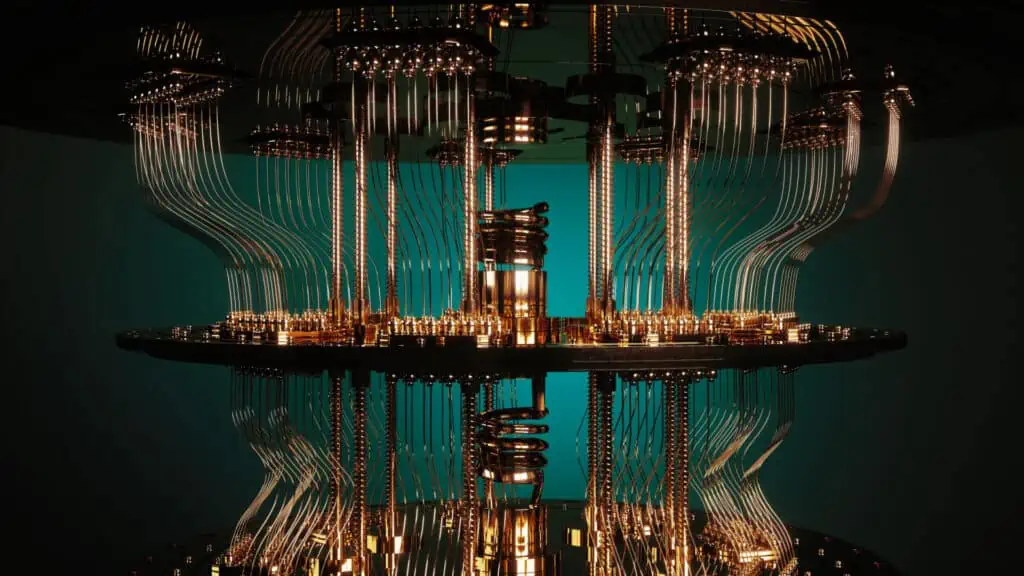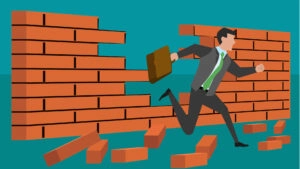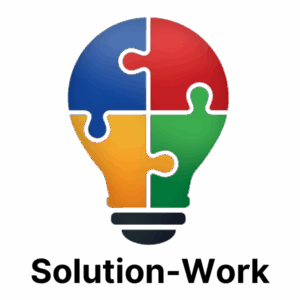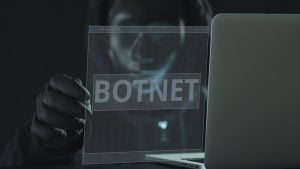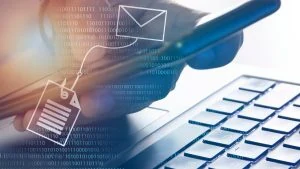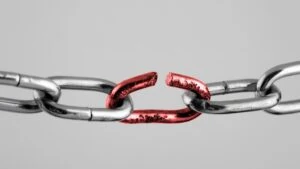Quantum computers work according to a completely different concept than conventional computers. This makes them so incredibly fast that they are believed to have the potential to bring about revolutionary changes in various fields. Find out how this concept works and what applications are currently being developed in this article.
Content
What makes quantum computers so fast?
Classic computers use bits as the smallest unit of data processing. A bit can assume two states, either exactly 1 or exactly 0. The processors convert these values with “power on” and “power off”. The bits are independent of each other. Eight bits next to each other make a byte. Our current computers translate all information into binary code in order to be able to calculate with it. This applies to all programs, from simple calculations to space programs.
Since the first computer built by Konrad Zuse in 1957, computers have become smaller and faster. At the same time, they have retained the binary code principle. Quantum computers promise a quantum leap in performance. They are expected to far exceed the computing speed of today’s computers. Currently (May 2024), quantum technology is still at the research stage in many places. However, the European cloud provider OVHcloud has already launched the first quantum computer, the Quandela Quantum computer, in inaugurated for commercial use in France in March 2023. The German-Finnish start-up IQM launched a superconducting quantum computer for universities and laboratories in 2023, the basic version of which is expected to cost less than one million euros. If scientists succeed in getting other quantum computers to work as desired, they will significantly change the world of IT and many areas of our lives. Before we go into the applications, it is worth understanding why the new generation of computers can work so quickly in the first place.
From bits to qubits
In physics, the term “quantum” refers to the smallest possible measurable value of a physical quantity, similar to the pixels in a digital image. A quantum cannot be further subdivided and exists exclusively as a complete unit that can either be created or destroyed. A typical example of a quantum is the photon, the quantum of an electromagnetic wave, which includes visible light, radio waves, microwaves and others. In the context of quantum computers, a quantum can represent either a charged atom (ion) or a specific number of electrons in a circular current. Analogous to the bits in traditional computers, this quantum is called a qubit, which is the basic computing unit in quantum computers.
A qubit can not only represent 0 and 1, but theoretically an infinite number of states in between and all at the same time. Many values can therefore be accommodated in a single qubit. But how can a qubit assume different states at the same time and still produce correct calculation results? This phenomenon is called superposition.
Quantum computing uses three main concepts:
- Superposition
- Entanglement
- Interference
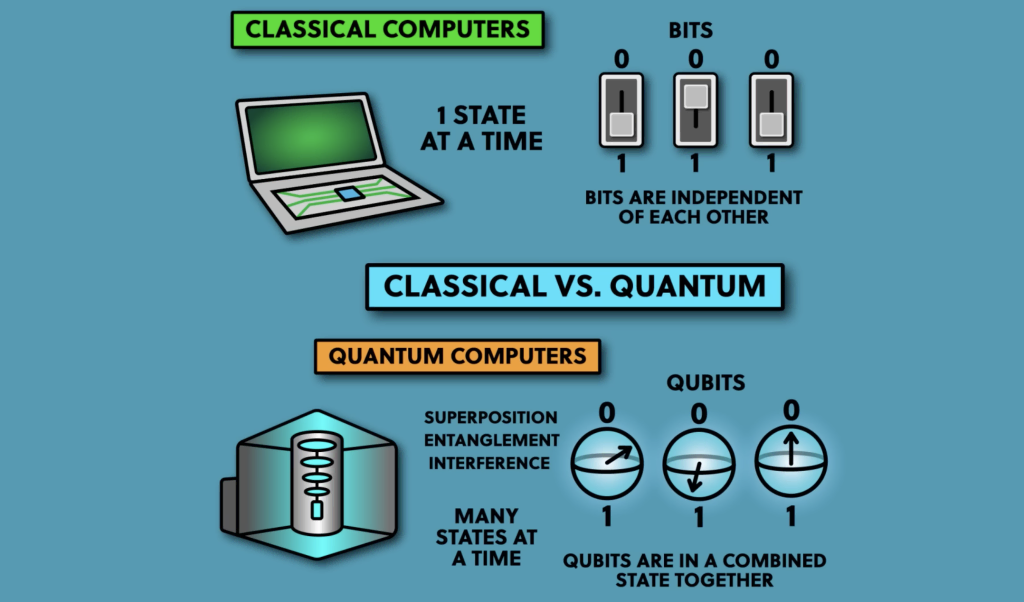
What is a superposition?
Qubits can occupy different states simultaneously. A qubit can be a combination of 0 and 1 at the same time, which gives quantum computers their enormous parallel computing capacity.
In classical computers, the basic units of information, the bits, are either 0 or 1 at any point in time. In contrast, a quantum computer uses quantum bits or qubits, which can simultaneously assume the states 0 and 1 and many states in between. The different states overlap. This phenomenon is called superposition. A qubit can therefore contain more information than a classical bit.
This can be used for certain tasks such as the factorization of large numbers, searching in unsorted databases and the simulation of quantum systems, whereby an exponential acceleration compared to the best known classical algorithms is possible. Superposition thus enables parallelism and a computing capacity that cannot be achieved with traditional computers. It is one of the key technologies that make quantum computers extremely powerful for special tasks.
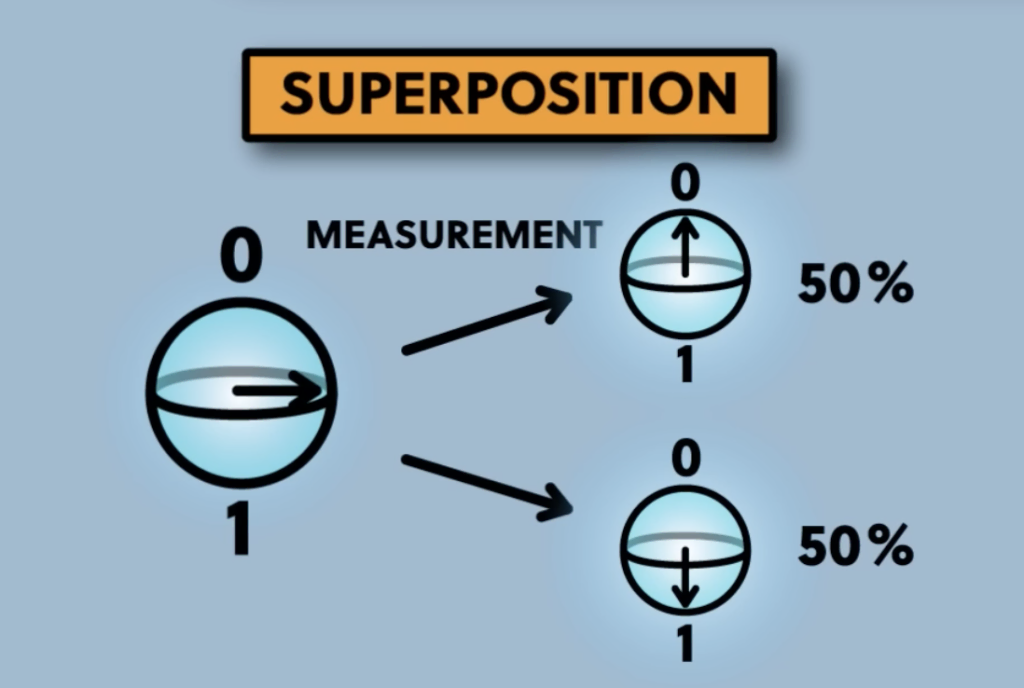
What is an entanglement?
Quantum entanglement is another fascinating phenomenon of quantum physics that plays a central role in the functioning of quantum computers.
Entanglement makes it possible for two or more qubits to be connected in a state in which the states of the individual qubits cannot be described independently of each other, but only as a common system. As soon as one of the qubits is changed, the other also changes.
Entanglement occurs when particles such as photons, electrons or atoms interact with each other and form states that depend on the states of the individual particles. An entangled pair of particles is described as a single quantum mechanical system whose state cannot be fully described by the states of the individual particles.
The more qubits there are and the more they are entangled with each other, the better the performance of the quantum computer.
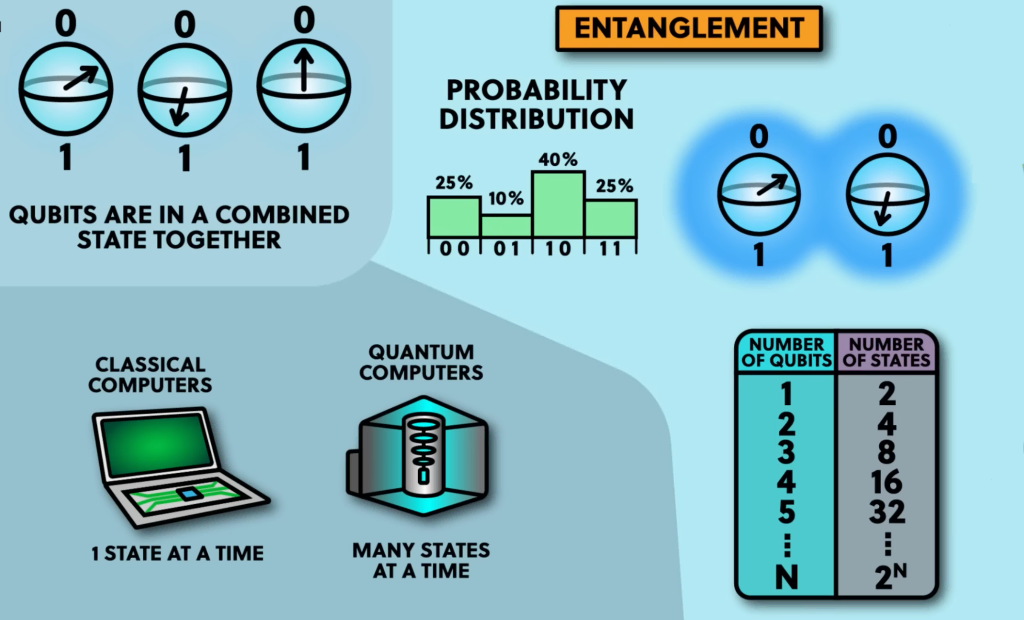
What does quantum interference mean?
Another important concept in quantum computing is that of quantum interference. It is used to increase the probability of getting the right answer to a calculation and eliminate the wrong ones. This is the effect that the probability waves associated with quantum states can overlap and interact with each other. This interaction can lead to a strengthening or weakening of the probabilities of certain states, which in turn is fundamental to the functioning of quantum computers.
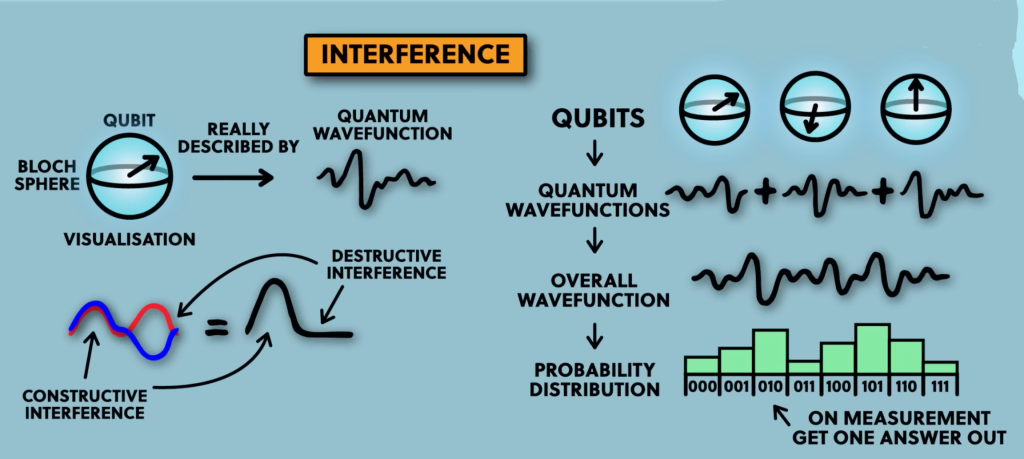
In quantum mechanics, each state of a particle (such as an electron or photon) is described by a wave function that contains information about all possible states of the particle. If two or more of these wave functions overlap in the same region of space, they can interfere with each other. This interference can be constructive or destructive.
- Constructive interference occurs when the wave functions overlap in such a way that their amplitudes add up in certain regions.
This leads to an increased probability of finding the particle in these regions.
- Destructive interference happens when the amplitudes of the wave functions cancel each other out, reducing the probability of finding the particle in these regions.
Application in quantum computers
In the context of quantum computing, quantum interference is used to perform calculations. A quantum algorithm designs a series of quantum operations (quantum gates) that put the qubits into superposition states and entanglement. These operations promote certain states of the qubits (constructive interference) and suppress others (destructive interference).
For example, in the famous Shor’s algorithm for factoring large numbers, quantum interference is used to increase the probability of measuring an answer that leads to a solution to the problem, while suppressing other, less useful answers.
Quantum interference is not only a proof of the non-intuitive properties of quantum mechanics, but also offers practical applications, such as drastically speeding up certain computations compared to classical computers. However, the control and utilization of quantum interference is extremely challenging, as environmental perturbations (such as thermal fluctuations or electromagnetic interference) can easily disturb the wave functions of the qubits, leading to computational errors.
The development of techniques to minimize such interference and the optimization of quantum circuits to exploit quantum interference are therefore key research topics in the field of quantum computing.
Quantum computer hardware
The production of quantum computers is extremely challenging, as qubits are extremely susceptible to external interference, which can lead to errors in the calculations. Various approaches to the realization of quantum computers include:
- Superconducting qubits that are kept stable by extremely cold temperatures.
They use the properties of superconducting materials, in which the electrical resistance disappears completely under certain conditions and the electric current can flow without any loss of energy. These properties are used to manipulate and measure the states of qubits, which are necessary for quantum computation.
Research institutions and companies such as IBM, Rigetti and various research groups in Germany are working intensively on the further development of superconducting qubits, and significant progress has already been made in terms of coherence time and error reduction. This technology is one of the most promising for future use in commercial quantum computers. - Trapped-ion qubits that keep ions trapped in a vacuum by electromagnetic fields.
Ions are atoms or molecules that carry an electrical charge because they have either lost electrons (which makes them positively charged) or gained electrons (which makes them negatively charged). At the core of ions is the principle of electroneutrality in uncharged atoms and molecules, where the number of protons (positively charged particles in the nucleus) and electrons (negatively charged particles orbiting the nucleus) are equal. By adding or removing electrons, this balance is disturbed and the atom or molecule becomes an ion. To use ions for quantum computing, they must first be kept in a stable state where they are not affected by their environment. This is achieved by enclosing them in a so-called “ion trap”. These traps use electromagnetic fields to position and move charged particles in space.
The ability to control ions in a vacuum through electromagnetic fields is central to the implementation of quantum computers. This allows precise manipulation of the quantum states of the ions by external influences such as lasers, which is essential for setting, reading and processing quantum information. The electromagnetic fields make it possible to hold the ions in precisely defined positions and to control their interactions in a targeted manner, which is necessary for the realization of quantum gates and the entanglement of qubits. - Topological qubits, a still experimental technology that could be more stable than existing qubit systems.
They are based on the principles of topology, a branch of mathematics that deals with properties of spaces that remain unchanged under continuous deformations (such as stretching and bending, but not tearing). In the quantum computing world, these topological properties are used to create qubits that are much more robust against disturbances and errors.
Scientists are actively developing systems that can provide the necessary conditions for topological qubits. Companies such as Microsoft are investing heavily in the research and development of technologies based on topological qubits, as the potential for robust, scalable quantum computers is enormous.
“Do you know why quantum computers never miss a date? Because they cover all possibilities at the same time!” 🎉
– Joke from chatGPT
Error correction and logical qubits
A major problem with quantum computing is the susceptibility of qubits to errors. In order to increase the reliability of quantum computers, intensive research is being conducted into error correction mechanisms. Recently, Microsoft and Quantinuum have made significant progress in this area by demonstrating logical qubits that are 800 times more error-prone than physical qubits.
Example Microsoft and Quantinuum
What is a logical qubit?
Logical qubits use an error correction scheme that groups physical qubits in such a way that the errors of a single qubit can be corrected without losing the information. This is a crucial step towards the realization of practical quantum computers.
A logical qubit consists of a group of physical qubits that are interconnected in such a way that the quantum information of the logical qubit is distributed across several physical qubits. This distribution allows that even if some of the physical qubits are affected by interference, the overall information of the logical qubit remains intact and errors can be corrected. The process typically includes:
Redundancy: Adding redundancy by using multiple physical qubits to represent one logical qubit increases the fault tolerance of the system.
Entanglement: The physical qubits of a logical qubit are entangled with each other in complex states. These entanglements are designed in such a way that error detection and correction can be carried out without affecting the stored information.
Error detection and correction: Special quantum circuits and algorithms are used to continuously detect and correct errors that occur during quantum computations.
Overall, logic qubits play a central role in the development of practical quantum computers by providing a platform on which quantum information can be processed safely and reliably, free from most of the perturbations that otherwise affect quantum computation.
World-renowned locations for quantum technology in Germany
The development of quantum technology in Germany is progressing rapidly. Forschungszentrum Jülich in North Rhine-Westphalia, a member of the renowned Helmholtz Association, plays a key role in Europe. The scientists there are looking at the entire production chain of quantum computing – from the discovery of suitable materials, the design of circuits and cryo-electronics for the necessary cooling, through to prototype development and practical applications.
In addition to Jülich, important facilities for this advanced technology are also being established in other places in Germany. An important European hub for quantum computing is being established in Garching near Munich. In Ehingen, Baden-Württemberg, IBM is planning to open its first European quantum data center in 2024. IBM Quantum will provide users in the European cloud region with quantum systems and process data within the EU.
Applications of quantum computers
Quantum computers have the potential to bring about revolutionary changes in various fields.
Cryptography and post-quantum cryptography
Quantum computers could make existing encryption mechanisms obsolete by breaking algorithms such as RSA (Rivest-Shamir-Adleman) in practically usable periods of time.
For this reason, the development of algorithms that are secure against both quantum computers and traditional computers is being intensively pursued. The threat posed by quantum computers, which will be able to crack conventional encryption methods such as RSA, has led to a race in the research and development of post-quantum cryptography.
The National Institute of Standards and Technology (NIST) in the USA is playing a leading role in the standardization of new encryption methods for the post-quantum era. Of the 69 methods originally proposed, four were selected for standardization after intensive testing and several rounds of evaluation. These methods, including Sphincs+ and Crystals-Dilithium for authentication and Crystals-Kyber for secure key exchange, are based on complex mathematical operations that are also challenging for quantum computers. Prepare your organization for the quantum revolution: A guide to implementing post-quantum cryptography can be found here on SSL.com.
“Why couldn’t the quantum computer take part in the talent show? Every time the judges looked, it changed its performance!”
– chatGPT
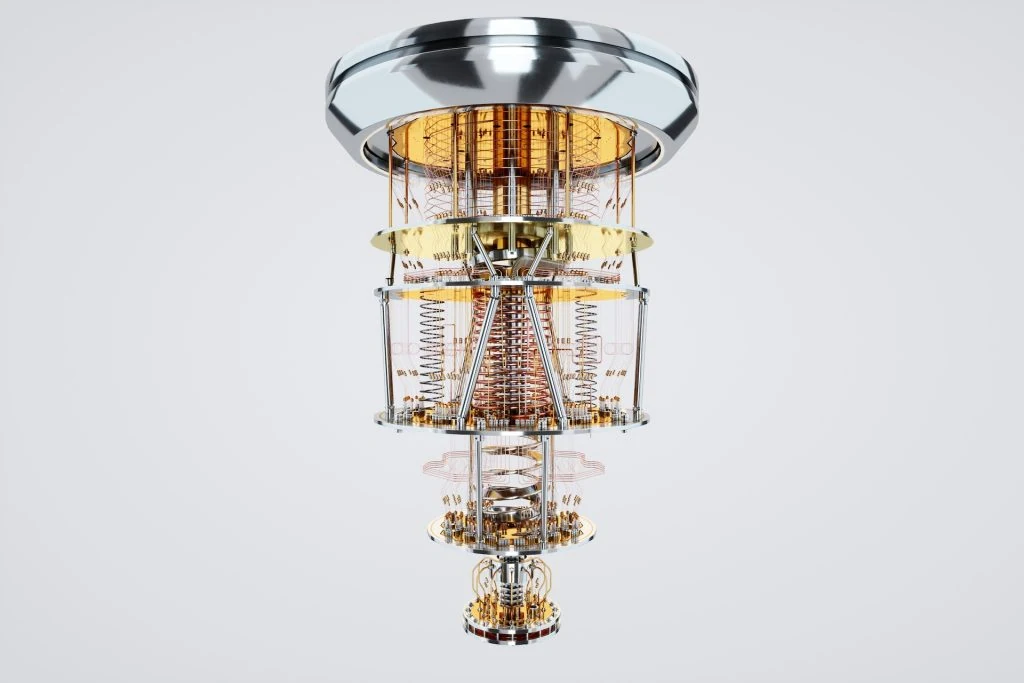
New and improved materials, more effective drugs
Quantum computers could model complex molecules, which could lead to new materials and medicines.
In particular, the ability of quantum computers to directly simulate quantum systems opens up new avenues for the research and development of new materials.
Here are some key aspects of how quantum computers are being applied in materials science:
Simulation of quantum materials: Quantum computers can simulate the properties of materials at the atomic level by directly reproducing the quantum mechanical interactions between atoms and molecules. This is particularly valuable, as classical computers quickly reach their limits when it comes to the precise calculation of quantum effects.
For example, quantum computers can be used to understand and predict electronic properties of materials such as conductivity, magnetism and superconductivity. Or to simulate complex chemical reactions that occur in catalysts and other functional materials.
Designing new materials: The ability to perform precise simulations enables scientists to design new materials with customized properties. This includes the development of high-performance batteries: Quantum computers can help design materials for more efficient and longer-lasting battery cells. This also includes the invention of new superconductors. By simulating electron structure and dynamics at low temperatures, quantum computers can contribute to the discovery of materials that are superconducting at higher temperatures.
Optimization of materials: In addition to discovering new materials, quantum computers can also be used to optimize existing materials. For example:
- Improvement of alloys: By simulating atomic interactions, the mechanical properties of alloys can be improved, which is important in the aerospace industry, for example.
- Development of more efficient catalysts: By understanding the reaction mechanisms at the molecular level, more efficient catalysts can be developed for the chemical industry.
Accelerating materials research: Quantum computers can significantly accelerate the speed at which new materials are discovered and developed. The ability to perform fast and accurate simulations reduces the need for lengthy experimental testing and can dramatically shorten the time from conceptualization to market.
Challenges: The application of quantum computers in materials science still faces considerable challenges:
- Scalability: Most current quantum computers do not yet have enough qubits to comprehensively simulate complex material systems.
- Error-proneness: Due to the error-proneness of current quantum computers, extensive error correction mechanisms are required to ensure reliable results.
- Software and algorithms: There is a need for more advanced software and specialized algorithms that are optimized for materials science simulation.
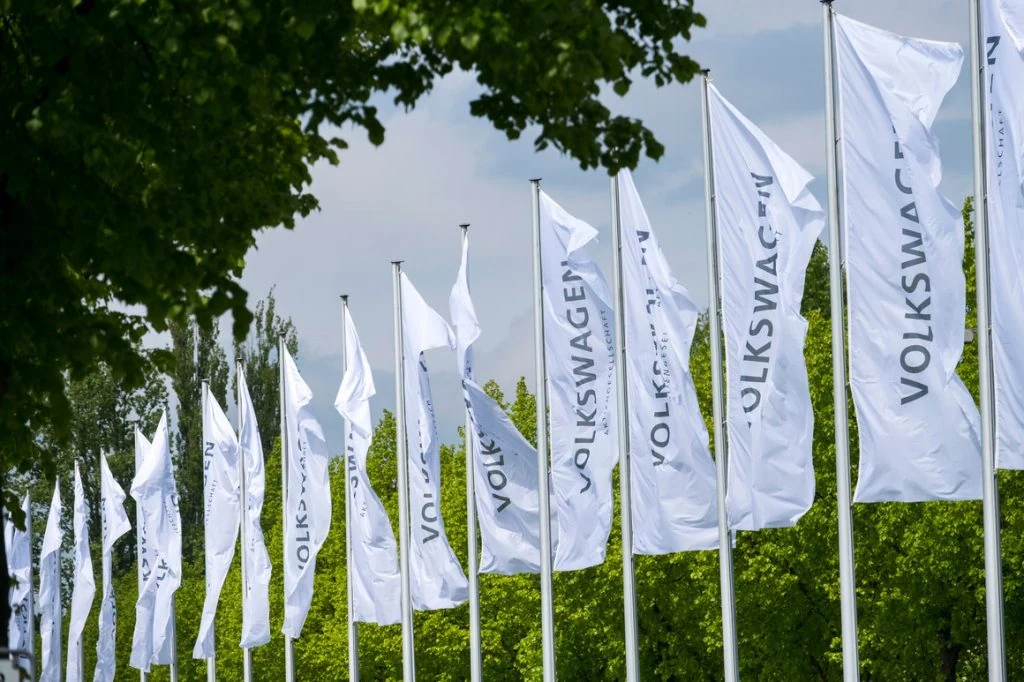
Example Volkswagen
Volkswagen AG and the Canadian company Xanadu have launched a multi-year research program in 2022 to optimize the computing power of quantum algorithms for the simulation of battery materials. The aim is to reduce computing costs and accelerate the use of quantum computers at Volkswagen for the development of safer, lighter and more cost-effective battery materials.
Example JPMorgan Chase, Toshiba and Ciena
JPMorgan Chase, Toshiba and Ciena are building the first quantum key distribution network to secure mission-critical blockchain applications. The research team demonstrated that the newly developed Quantum Key Distribution (QKD) network is capable of instantly detecting and defending against eavesdroppers. It also investigated the impact of realistic environmental factors on the quality of the quantum channel and used a QKD-secured optical channel to set up and secure Liink by J.P. Morgan, the world’s first bank-led, production-ready peer-to-peer blockchain network. This is QKD’s first demonstration of securing a mission-critical blockchain application in the industry.
Example Goldman Sachs
Quantum algorithms could perform complex financial calculations at breakneck speed. Finance was one of the first areas to embrace big data, and the drive for innovation continues. Much of the science behind the pricing of financial assets involves simulating a large number of different statistical possibilities – the power of quantum computing. That’s why Goldman Sachs has hired leading researchers. The team is developing applications that will help to quickly assess the markets and sometimes change the way we value certain financial instruments.
“Why are quantum computers the party animals of computer technology? Because they are everywhere and nowhere at the same time and always good for a surprise! ” 🎉
Joke from chatGPT
Logistics and production – solving optimization problems
Quantum computers offer promising approaches for solving optimization problems that arise in areas such as logistics and production. These problems are often extremely complex and difficult to solve, especially when they involve a large number of variables and constraints. Quantum computers can potentially find more efficient solutions to such problems by utilizing their ability to perform an enormous amount of computation simultaneously (quantum parallelism) and explore complex states. Here are some key aspects of how quantum computers can be used in optimization:
Quantum annealing and QAOA: A prominent approach in quantum optimization is quantum annealing. This method uses quantum fluctuations to find a global minimum of an objective function, which corresponds to an optimal solution state. Quantum annealing is particularly well suited for problems where many local minima exist, as it allows the system to “skip” them and find more efficient global solutions.
Fast Annealing – New feature from D-Wave
D-Wave Quantum Inc. announced in April 2024 the Fast Anneal feature to be available on all of D-Wave’s quantum processing units (QPUs) in the Leap real-time quantum cloud service. Fast Anneal is expected to impact a wide range of quantum computing applications, from advancing scientific research in quantum simulation and AI to solving real-world problems in various industries. Fast annealing shortens the time required to switch from one energetic state to another. This can be useful for performing quick iterative tests and adjustments when searching for solutions. Users can try out different scenarios in less time.
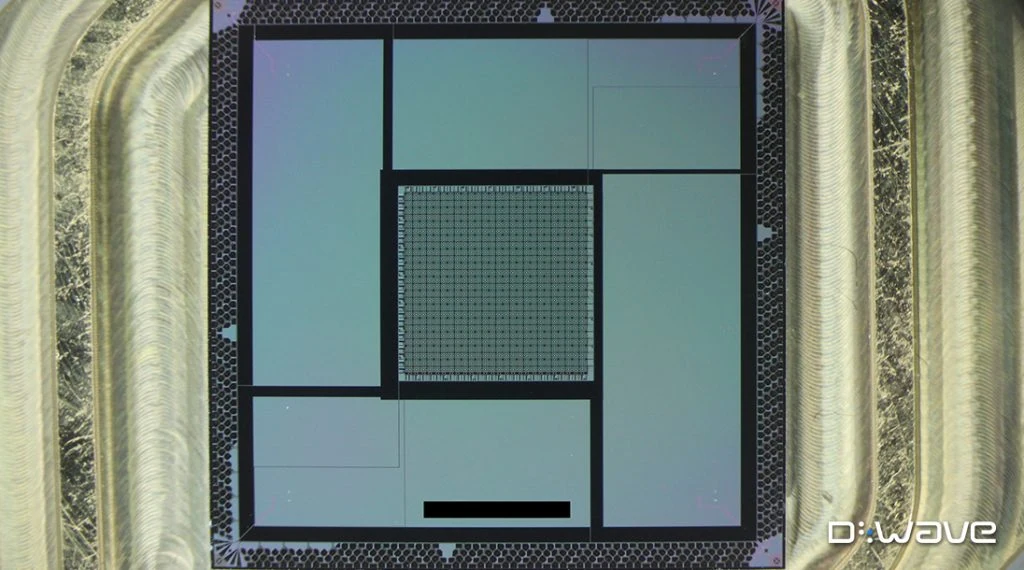
A related but more general concept is the Quantum Approximate Optimization Algorithm (QAOA), which was developed for digital quantum computers. QAOA uses a combination of quantum superposition and interference to create a sequence of quantum mechanical operations (gates) that increase the probability of finding the optimal solution to a problem
In logistics and production, such quantum techniques can be used to solve a variety of optimization problems, including:
- Vehicle routing: Optimizing the routes that vehicles should take to deliver goods. Quantum annealing can be used to find the optimal sequence of delivery or pick-up points, minimizing overall fuel and time costs.
- Production planning: In manufacturing, production schedules often need to be optimized to maximize machine utilization, minimize lead time and reduce changeover times between different production tasks. Quantum computers can potentially develop more efficient plans in less time.
- Warehousing and inventory management: Optimization of stock levels to ensure the availability of products while minimizing storage costs. Quantum methods could help to simulate and optimize complex warehousing models.
Advantages of quantum optimization
The speed and quality of the solutions are the key advantages of quantum computing. Thanks to quantum parallelism, it is possible to explore many possible solutions simultaneously. This means that results can be achieved much faster. Quantum technologies can help to find better quality solutions that might not be discovered using classical algorithms.
The future of quantum computing
The theory of quantum computing is very promising. However, there are still considerable challenges to overcome before practical implementation and widespread use. These include scaling the systems and further reducing the qubits’ susceptibility to errors. In addition, questions regarding the programming of quantum computers and their integration into existing IT infrastructures remain unanswered. Companies and governments around the world are investing considerable resources to develop the first practical quantum computers. In light of these developments, we could soon witness how quantum computing fundamentally changes the way we think about data processing.
McKinsey forecasts gigantic market potential
Quantum technology could create trillions of dollars in value within the next decade. For example, the McKinsey analysis“Quantum Technology Monitor“, published in April 2024, shows that four sectors – chemicals, life sciences, finance and mobility – are likely to experience the earliest impact of quantum computing and could gain up to 2 trillion dollars by 2035.
Public funding for quantum technologies, on the other hand, has increased by more than 50 percent compared to 2022, according to McKinsey. While China and the United States have so far dominated public investment in quantum technology, new announcements from Australia, Canada, Germany, India, Japan, the Netherlands, South Korea and the United Kingdom reflect the growing recognition by a wider range of governments of the importance of quantum technology; South Korea and the United Kingdom in particular have significantly increased their funding levels.
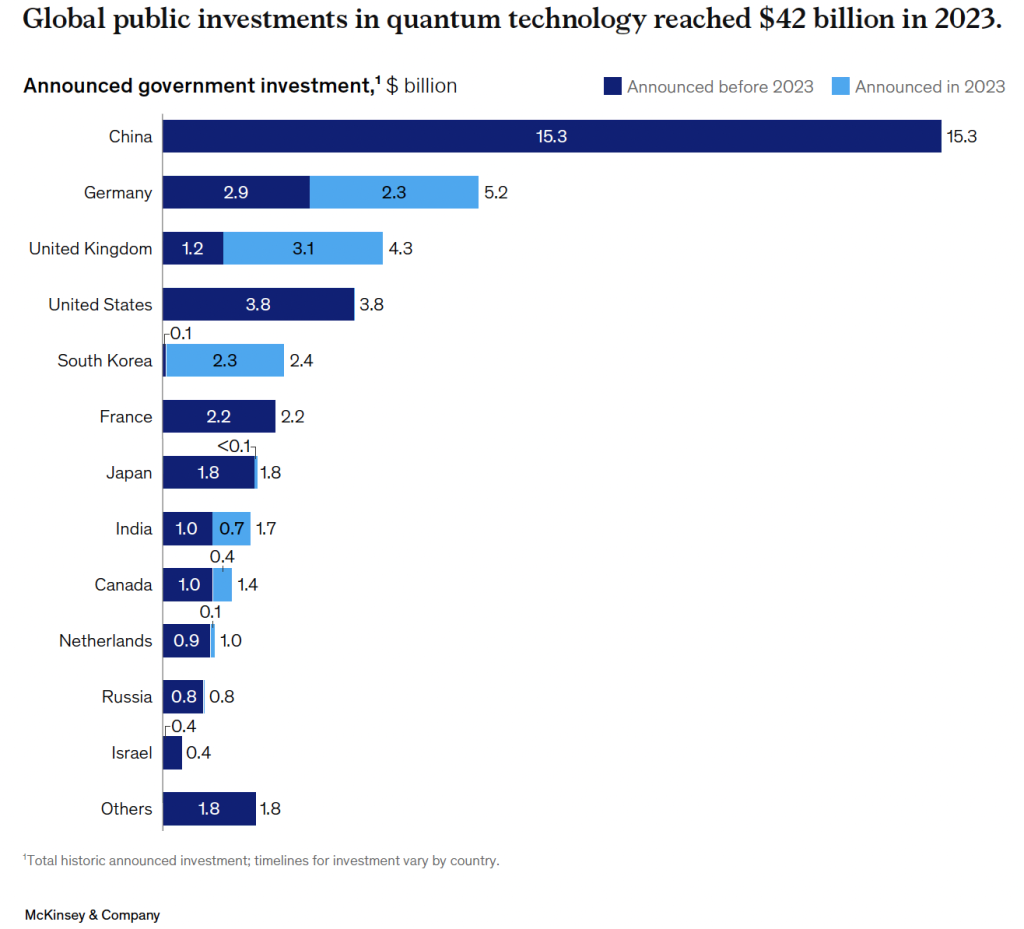
Talent development also took a notable step forward in 2023, reflecting a positive focus on building quantum technology (QT) foundations. The number of graduates with QT-related degrees in 2023 was 367,000, the number of universities with QT programs increased by 8.3 percent to 195, and the number of universities with master’s degrees in QT increased by 10.0 percent to 55, according to McKinsey. The European Union and the United Kingdom have the highest number and density of graduates in QT-related subjects, respectively. This surge explains why scientists from EU institutions have contributed the most to quantum-related publications.
Quantum computers as a replacement, supplement or in hybrid use
Quantum computers will not completely replace conventional computers, but rather complement them. They are specifically designed for certain types of problems that are difficult or inefficient for classical computers to solve, such as the applications described above. Quantum computers require special conditions, such as extremely low temperatures and a controlled environment, to keep their qubits stable and manipulate them. These requirements make them expensive and complex to maintain compared to traditional computers.
The technology of quantum computers is not yet fully developed. Technological challenges, including error-proneness and scaling, still need to be overcome. In many cases, it is likely that the best solutions will involve a combination of classical and quantum computing techniques. Hybrid approaches, where quantum and classical computers work together to solve problems, could become more commonplace.
The dangers of quantum computing
Every new technology, no matter how golden and sparkling, also has its downsides. Quantum computing has potential risks and challenges, both technical and ethical. Here are some of the main concerns:
- Cryptographic security
One of the biggest potential risks associated with quantum computers is their ability to break existing cryptographic protocols. Many of the encryption methods used today, including RSA and ECC, which are used to secure the internet, could be effectively compromised by quantum computers. This would threaten the security of digital communications, online banking, data protection and many other security-critical systems. - Power imbalance
The high costs and complex infrastructure required to operate and maintain quantum computers could mean that only a few, mostly large organizations have access to this technology. This could create a power imbalance where a few players have excessive influence over important technologies and data. - Economic disruption
The capabilities of quantum computers could also cause significant economic upheaval. Industries that rely heavily on current cryptography could be significantly disrupted. Companies that do not adapt quickly to the new quantum technology could fall behind. - Ethics and control
The application of quantum computing in areas such as artificial intelligence could lead to more advanced, potentially autonomous systems whose behavior is difficult to predict and control. The ethical implications of such technologies, including surveillance and decision-making, are complex and require careful consideration and regulation. - Technological arms race
Quantum computing could lead to a technological arms race between states, particularly in the area of cybersecurity and military technology. The ability to quickly decode information or perform complex simulations could influence the balance of power on a global scale. - Susceptibility to errors and reliability
Due to their complexity and sensitivity to environmental influences, quantum computers are particularly susceptible to errors. The development of effective error correction mechanisms is crucial, but until these are fully realized, errors in quantum computations could lead to inaccurate or misleading results.
Conclusion
Quantum computing represents both an extraordinary opportunity and a significant challenge. The potential risks require foresight, ethical considerations and potentially new regulatory approaches to ensure that the benefits of this powerful technology can be harnessed for the good of all


